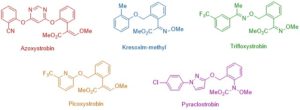→ Project Reference: AGL2006-12750-C02-01/02
![]()
Summary
The increasing occurrence of fungicide resistant fungi strains due to the almost exclusive and intensive use of a few active materials has led to a progressive loss of the efficacy of these products in the control of fungal infections in horticultural products. Given this circumstance, a number of new fungicides have appeared on the market in recent years, which have provided producers with a set of new phytosanitary chemical tools to combat the economic losses caused by these plant pathogens. These new products are prominent because of their high efficacy, moderate toxicity and compatibility with integrated pest management programs. Particularly, a new family of fungicides, known as strobilurins, has commercialized whose members include active principles such as azoxystrobin, kresoxim-methyl, trifloxystrobin, picoxystrobin and pyraclostrobin. These agrochemicals have a different mode of action, which has allowed a more effective fight against the appearance of resistance. The available statistics clearly show the increasing use of these emerging products, which in turn will increase the occurrence of residues of these fungicides in usual analytical controls.

Exposure of the general population, and especially children, to residues of chemical contaminants through diet due to the application of these compounds in horticultural products is a cause of concern for consumers. Government agencies and producers themselves have an obligation to ensure scrupulous compliance with regulations and the correct application of treatments, so that the residue content of the products that reach the market is the lowest possible and do not exceed the established limits. Therefore, sampling and monitoring programs, combined with prevention measures and effective risk assessment, management and communication, are required in order to increase the confidence of citizens in the safety of the consumed foodstuffs. As the current national and European scientific guidelines state, it would be desirable to have new analytical methods for the determination of residues of this type of products which, in addition to providing results with the necessary accuracy and precision, should be capable of analyzing a large number of samples in a short time, economically and without the need for expensive equipment and/or highly qualified personnel.
It is in this context that this research project has been developed, whose most relevant achievement has been the development of kit immunoassays for the analysis of the most relevant commercial strobilurin fungicides in food samples in a simple, rapid and economic way. These new bioanalytical methods have been shown to have a very high sensitivity and specificity, which has allowed the determination of very low concentrations of these fungicides in juices, cereals, beer, fruit and vegetables. We are confident that in the medium term these analytical tools can arouse the interest of the productive sectors involved and that of the regulatory authorities, becoming useful methodologies that contribute to guarantee the chemical safety of the foods we consume.

 Español
Español